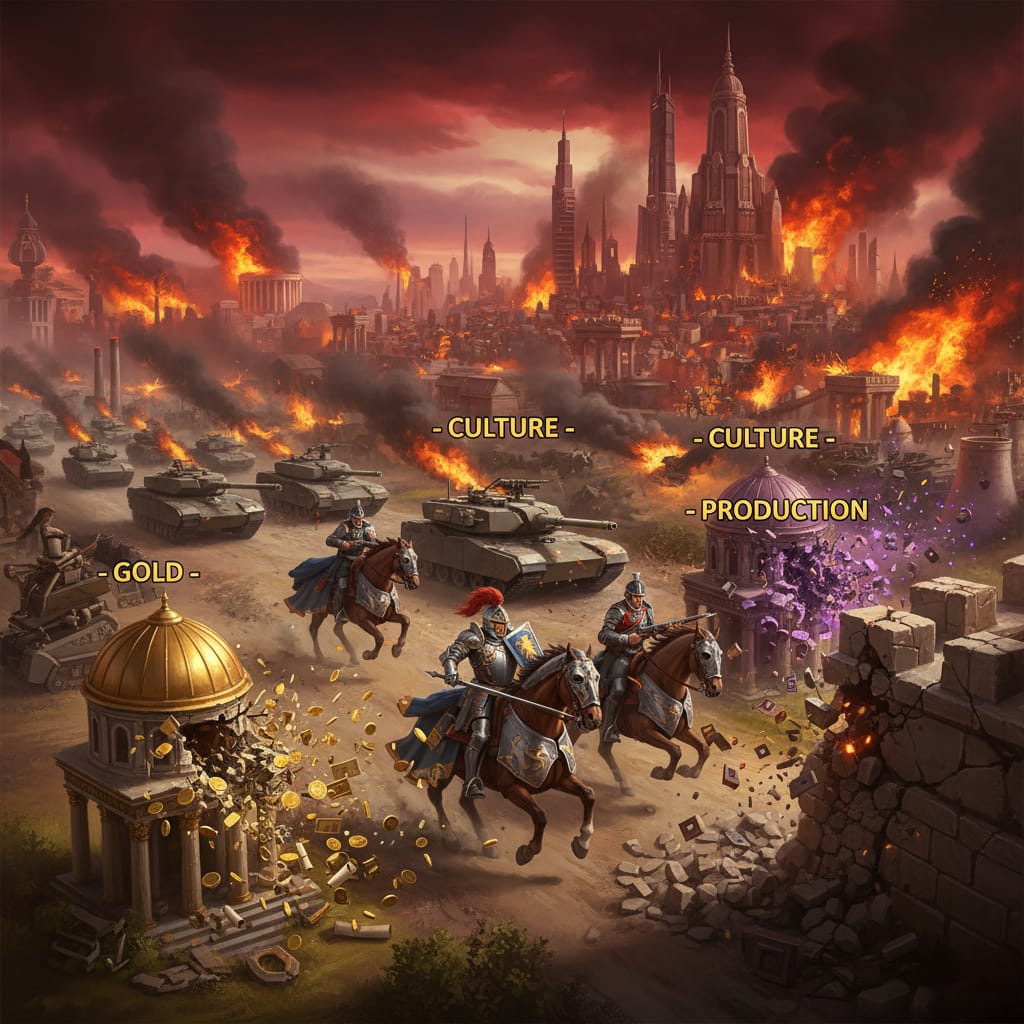In the grand tapestry of Civilization 6 strategy, every unit has a role, a purpose etched into the game’s intricate balance. Light cavalry units are the swift-fanged wolves, designed for harassment, flanking, and, most critically, pillaging the lifeblood of an enemy’s empire. Heavy cavalry, the iron-fisted fist of conquest, are the line-breakers, the city-takers, the decisive force in open-field battle. But what if this fundamental distinction was shattered? What if the game’s code was rewritten to grant all heavy cavalry units—from the noble Knight to the rumbling Modern Armor—the ability to pillage a district without ending their turn? This single, seemingly simple change would not merely tweak the meta; it would detonate it, fundamentally reshaping the very nature of warfare, economic strategy, and the balance of power from the Classical era to the Atomic. The age of the unstoppable blitzkrieg would be upon us.
The New Blitzkrieg: Redefining Offensive Warfare
Analysis on forums and in deep-dive strategy sessions consistently highlights the concept of “action economy” as a cornerstone of tactical success in Civilization 6. Every unit’s move and action per turn is a precious resource. The current system forces a difficult choice upon a general: does your Knight attack the enemy crossbowman, or does it pillage the adjacent Campus to steal precious science and heal? You cannot do both. This limitation acts as a crucial brake on the tempo of an invasion.
By removing this brake for heavy cavalry, the game would introduce a terrifying new form of offensive warfare. A unit like a Knight, with its base 4 movement points, could move adjacent to an enemy district, pillage it for a burst of resources and to lower the city’s defenses, and still have its full attack available to strike a defending unit or the city center itself. This transforms the heavy cavalry from a blunt instrument of attack into a multi-faceted tool of destruction, capable of executing a “pillage and destroy” doctrine in a single, fluid motion.
Consider a mid-game push with a force of Coursers or Knights. Under the current rules, this is a potent but manageable threat. With our hypothetical change, it becomes a nightmare. A wave of Knights could descend upon a city, and in one turn, systematically pillage the Commercial Hub for gold, the Theater Square for culture, and the Industrial Zone to halt production, all while simultaneously engaging and destroying the city’s defenders. The city’s combat strength would plummet from the pillaged districts, making it ripe for capture on the very same or the following turn. According to the player community, this would make timing pushes with heavy cavalry the single most dominant strategy in the game, capable of ending wars before the defender has a chance to mount a meaningful response.
Economic Warfare Perfected: The Unstoppable Pillage Machine
While light cavalry are the current masters of pillaging, they are a high-risk, high-reward unit. Their lower combat strength makes them vulnerable to being picked off by city defenses or enemy units. Sending a lone Horseman deep into enemy territory to pillage is a gamble. Sending a Knight or a Tank, however, is a statement.
With the ability to pillage districts for free, heavy cavalry would become the ultimate engine of economic warfare. Their superior durability means they could operate in hostile territory with a degree of impunity that light cavalry can only dream of. A player could confidently send a corps of Cuirassiers into the heart of an enemy empire, knowing they could withstand significant punishment while systematically dismantling the opponent’s infrastructure.
Many professional gamers suggest that the yields from pillaging are one of the most underrated aspects of warfare. A successful pillaging campaign can be more valuable than capturing a city, providing a massive, immediate injection of science, culture, gold, and faith. Now, imagine that campaign being waged by units that are not only resilient but also don’t have to sacrifice their offensive momentum to do it. A single Tank, with 5 movement points, could potentially pillage a district and still move 2-3 tiles deeper into enemy lands, or pillage and then attack. The snowball effect would be astronomical. A civilization that successfully executes a heavy cavalry pillaging campaign would not only cripple their opponent but also catapult their own economy and research far ahead of the competition. The rich would get richer, and the poor would see their empires burn.
A Shift in Unit Dynamics: The Devaluation of Light Cavalry and Defenses
Every major change in a complex system like Civilization 6 creates winners and losers. In this new reality, the traditional roles of several unit types would be irrevocably altered.
Light cavalry, while still useful for their raw speed, flanking bonuses, and specific promotions like Depredation, would see their primary strategic value severely diminished. Why build a fragile Courser for pillaging when a sturdy Knight can do the job just as well, if not better, without sacrificing its attack? The light cavalry line would likely be relegated to a niche role, used for scouting and picking off already-weakened units, rather than as a core component of a military strategy.
Defensive strategies would also face a crisis of identity. Currently, a well-placed encampment, a wall of anti-cavalry units, and a fortified city center can hold off a superior force, buying time for reinforcements or a diplomatic solution. But how do you defend against an army that can heal, steal your resources, and attack all in the same turn? A line of Pikemen is a deterrent to a charging Knight, but it’s far less effective against a Knight that can simply pillage a nearby farm to heal any damage taken before continuing its assault. According to the player community, this would likely force a meta shift away from “turtling” and towards a more aggressive, proactive military posture. The best defense, in this new world, would be an overwhelming offense.
Strategic Timings and Power Spikes: The Race to Heavy Cavalry
The Civilization 6 metagame is already defined by key technological and civic power spikes. The race to Crossbowmen, the timing of a Frigate rush, the unlocking of Artillery—these are the moments that can decide the fate of an empire. Our hypothetical change would elevate the heavy cavalry power spikes to a level of importance that would dwarf all others.
The race to Stirrups (for Knights) and later, Ballistics (for Cuirassiers) and Combustion (for Tanks) would become the central focus of the game for any aspiring conqueror. A player who reaches Knights while their neighbors are still fielding Swordsmen and Archers would have a window of opportunity to inflict catastrophic, potentially game-ending damage. This would create a more volatile and aggressive game, where falling behind in military technology would be a death sentence.
This effect would ripple through every era. In the Modern era, an army of Tanks would be a truly terrifying sight. They could roll across the continent, pillaging entire cities in a single turn, crippling production, stealing technology, and crushing any resistance under their treads. The strategic calculus would shift from a complex game of combined arms to a simple, brutal equation: who has the most, and the most advanced, heavy cavalry?
Civilization-Specific Implications: Winners and Losers
This radical change would not affect all civilizations equally. Some would rise to god-tier status, while others would find their unique strengths nullified.
The Winners:
- Byzantium (Basil II): Already a top-tier domination civ, Byzantium would become utterly unstoppable. Their ability to get free heavy cavalry units from Hippodromes, combined with the Tagma’s combat bonus, would create an endless, self-funding tide of destruction. Each city with a Hippodrome would become a factory for units that could pillage their way to victory.
- Hungary (Matthias Corvinus): Hungary’s ability to levy city-state units and grant them massive combat and movement bonuses would become even more potent. A levied army of Knights or Coursers, now able to pillage for free, would be a force of nature.
- Germany (Frederick Barbarossa): Germany’s extra military policy slot would be a significant advantage, allowing them to stack even more bonuses onto their already-powerful heavy cavalry. Cards like Chivalry and Lightning Warfare would become even more valuable.
- Mongolia (Genghis Khan): While their unique unit, the Keshig, is a light cavalry unit, their overall focus on cavalry and the ability to capture enemy cavalry would still make them a major threat in this new meta.
The Losers:
- Defensive Civilizations: Civilizations that rely on strong walls and defensive terrain, like the Inca or Vietnam, would find their advantages significantly reduced.
- Infantry-Focused Civilizations: Civilizations with unique infantry units, like Rome or Japan, would struggle to counter the sheer speed and power of the new heavy cavalry meta.
- District-Adjacency Civilizations: Civilizations that rely on tightly-packed districts for adjacency bonuses, like Japan or the Netherlands, would be creating perfect, high-value targets for pillaging heavy cavalry.
Counter-Strategies: Adapting to the New Meta
Even in a world dominated by god-tier heavy cavalry, no strategy is without its counters. Adapting to this new meta would require a shift in thinking, but it would not be impossible.
A popular strategy is to use terrain to one’s advantage. Forcing heavy cavalry into choke points, across rivers, or into hills and forests would slow them down and make them vulnerable to counter-attack. A dense formation of anti-cavalry units in a well-chosen defensive position could still trade effectively, even if they couldn’t stop the pillaging entirely.
In the later game, air power would become the ultimate equalizer. A squadron of Bombers could wreak havoc on a large formation of Tanks or Mechanized Infantry, turning their greatest strength—their concentration of force—into a fatal weakness.
Diplomacy would also play an even more critical role. Faced with a runaway player who is snowballing with their heavy cavalry, the other players on the map would have to form alliances and declare joint wars to have any hope of stopping them. The “world police” aspect of Civilization 6’s diplomacy would become a necessity for survival.
In conclusion, the simple act of allowing heavy cavalry to pillage districts without ending their turn would be a seismic event in the world of Civilization 6. It would transform the heavy cavalry from a powerful but specialized unit into the undisputed king of the battlefield, a multi-talented agent of destruction capable of waging war on both the military and economic fronts simultaneously. This change would accelerate the pace of the game, reward aggressive expansion, and create a new set of winners and losers among the game’s diverse roster of civilizations. The age of the horse, and later the tank, would be an age of fire, plunder, and relentless conquest.


